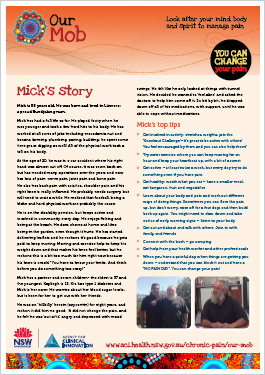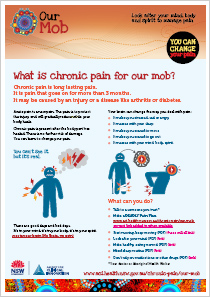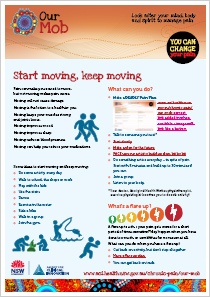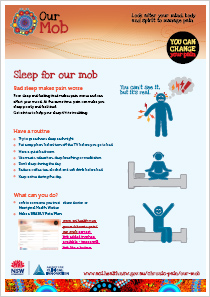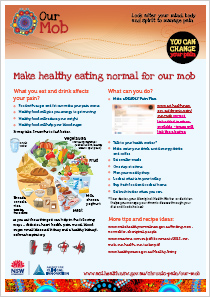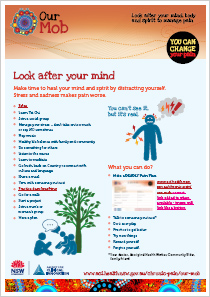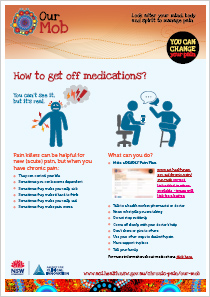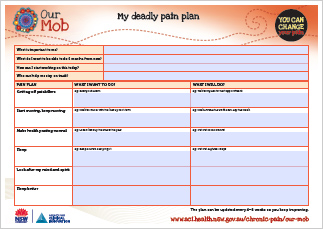Our Mob
Resources for Aboriginal People
About the Artwork
The artist Danielle Sullivan was born in Fairfield Sydney NSW, an urban community that is a far reach from the remote dust of Brewarrina where her mother came from. She acknowledges her culture through the Kunja peoples of the Cunnamulla region in South Western Queensland, and pays respect to the broader family and their special places on both sides of the Queensland and New South Wales borders.
Click on a section below to highlight the artwork:
- Healthy food, bush tucker, fresh food
- The purple represents calmness. No Stress.
- Get active. Exercise. Raising hearbeat.
- People around us to support.
- Red, orange, and yellow circles represent flare ups. Some bigger than others.
- Black line represents chronic pain, continuious line - life journey.
- Green line represents healthy outer with white glow (dots) the healthy life we strive for.
Artworks and Stories
A statewide art competition was initiated to identify a logo that was suitable for the website ‘Our mob’. Aboriginal artists were requested to enter pieces that signified pain for Aboriginal people and communities. Thirteen pieces of art were received. These artworks have been purchased by the NSW Agency for Clinical Innovation.
View artworks together with their story

Danielle Mate Sullivan
Acrylic on paper 2017
Danielle is a proud Kunja woman, who uses her experiences to inspire her art. She was born in Fairfield, a great distance from Brewarrina where her mother came from. The traditional symbols used in her art are enough to tell the story depicted, similar to the way her ancestors have told their stories for thousands of years.
Artwork 1
The artwork has various traditional symbols and colours, symbolic of different aspects of a healthy life. The hues of purple used in the artwork represent a sense of calm and minimal stress, with the reds, yellows and oranges representing pain and the flair ups that can occur for someone living with chronic pain. The green and white around the edge of the artwork is symbolic for the healthy life that people strive for.
The artwork contains symbols of bush tucker, healthy eating and exercise. The artwork illustrates the support networks people living with chronic pain form around them, and the black line throughout the artwork symbolises the long, continuous journey people with chronic pain go through.

Danielle Mate Sullivan
Acrylic on paper 2017
Danielle finds it very difficult to describe in her words ‘why’ and ‘what’ brings about the choices she makes with forming and finishing unique artworks. In her words, for thousands of years Aboriginal people have been using symbolism and art forms to communicate and recount stories and have not been reliant on the use of labelling or using paragraphs of words to share stories.
This artwork is depicted on a brown background, symbolic of the earth. The black dots in the art represent the support a person receives, with the yellow sun symbolic of the sun and good days for people living with chronic pain. The red and orange lines represent continuous pain, and the blue lines represent calmness and minimal stress. The centre in the circle is used to symbolise the person living with the chronic pain.
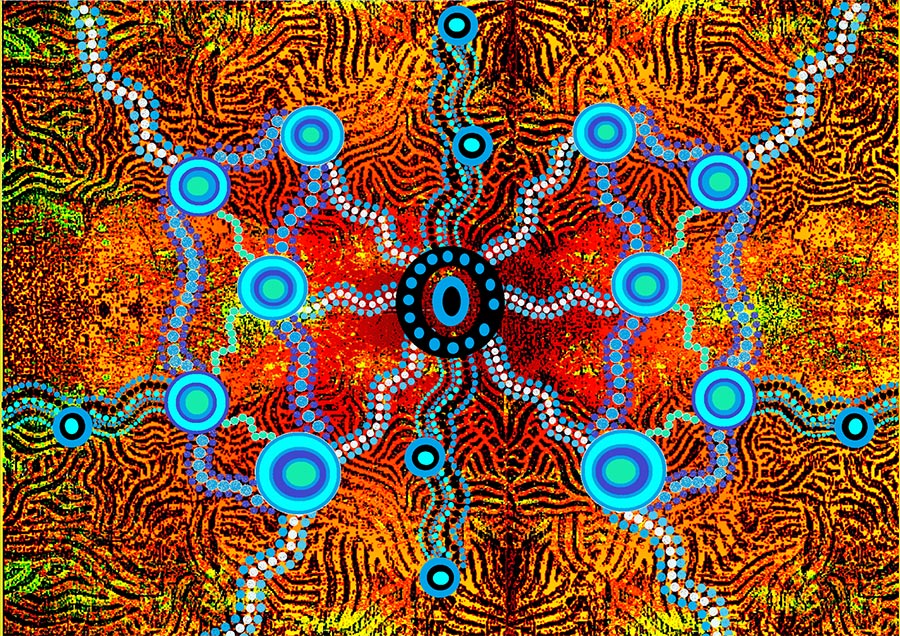
Daniel Roberts
Digital Image, 2017
Daniel, a proud Bundjalung man from Cabbage Tree Island in New South Wales, tells the story of communities in the area suffering from chronic illnesses. These chronic illnesses are resulting in reduced life expectancy.
The yellow, red and black in the background of the artwork is representative of a burning flame, symbolic of the need to stop the ongoing suffering within families and communities, in Aboriginal culture.
The blue dots and circles symbolise change and the journey taken to overcome chronic illness, with the black shadow illustrative of the stigma surrounding Aboriginal communities and the suffering experienced as a result. Grief and loss, and the effect it has on communities and families are explored through the artwork, specifically how it has casts a shadow from one generation to the next. The blue used in the artwork symbolises hope and positive change in the community; change for a healthy today and living for a healthy tomorrow.
“To Continue for a life time of Healthy Generations to come”
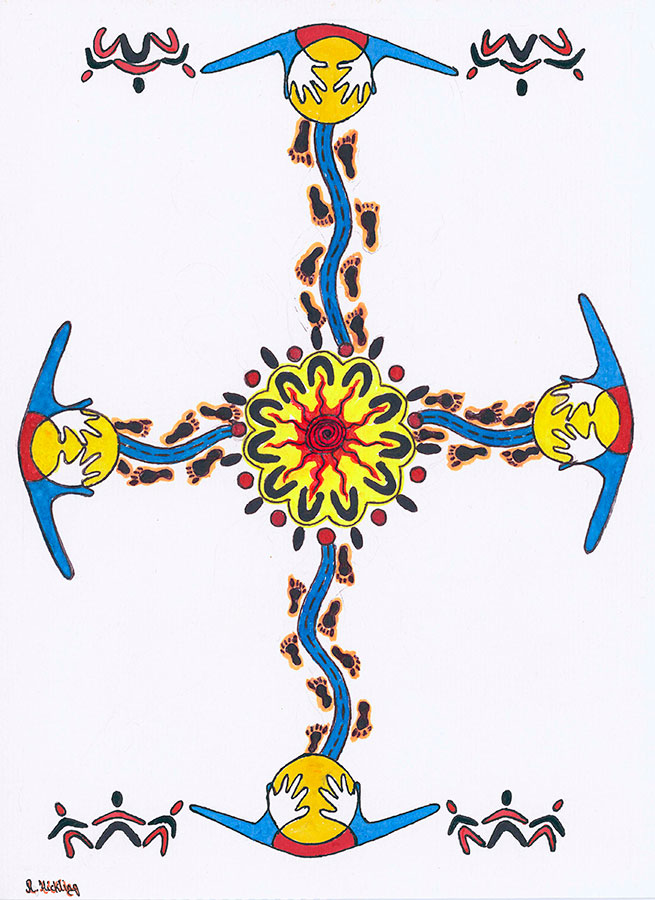
Hank Hickling
Drawing on paper 2017
Hank is from casino NSW. He has used lived experience with chronic pain to inspire his artwork.
The colour red is used to represent chronic pain, grief and loss that are present in all of the Aboriginal communities across New South Wales. The black designs demonstrate the Aboriginal community joining hands in unity and presenting as a united front to tackle pain.
The footprints in the artwork signify people in the community and their travel to services all over the state, which result in a healthy lifestyle and prevention of further chronic illness. The service providers in the community are represented in the artwork by the hands within the yellow circle. The hands show the providers working together to provide support to the different communities.

Lani Balzan
Acrylic on Canvas 2017
Lani’s artwork represents a person’s journey and coping through life on Country suffering with chronic disease, including pain. The isolation a person may experience from communities and families as a result of suffering from physical, mental and spiritual pain is explored.
Lani has incorporated personal experiences of chronic pain, and has emphasised the message that chronic pain does not define a person, but may help them to connect with others around them, and to build stories through their journeys.
There is hope that pain can be managed symbolised by the feather at the top of the artwork. The key strategies to manage pain include healthy lifestyle, good food, managing stress and exercise.
Lani depicts four connections - health, mind, body and spirit, which are all associated with the experience of pain. The smaller connections emerging from the fire represent coping with pain.
The Aboriginal figure in the centre is painted in red dots to describe the grief, loss and trauma experienced in life.
The stigma of pain, shame and isolation that may result is seen in the middle round circle which represents isolation. The hand print represents identity, a person’s suffering and shame.
The red dotted flames of fire represent the source of pain showing Aboriginal connection to Country and way of life and dealing with chronic pain and disease.

Leeanne Hunter - The Emotional Brain
Acrylic on Paper 2017
Leeanne is a mother of four children, descendant of the Wiradjuri people and she has been practicing fine art for 30 years. She explains that painting is a very powerful form of expression and is pleased that her work has been rewarded and will benefit the broader community.
She explains that the outer circle in this artwork is a traditional symbol for the place/ Country an Aboriginal person is in, or is a descendant of.
In the artwork, the boomerangs, a symbol of protection, include a wiggly line inside of them, demonstrating the distress that results from illness. The outline of the boomerang is indicative of the wrap around services that assist with the management of pain.
The image of the dissected brain depicts the hippocampus, symbolic of the distressed person. The magenta dots surrounding this image represent the relief gained through managing the pain. The colour magenta symbolises harmony and emotional balance, and promotes spirituality, practicality, common sense and a balanced outlook on life.
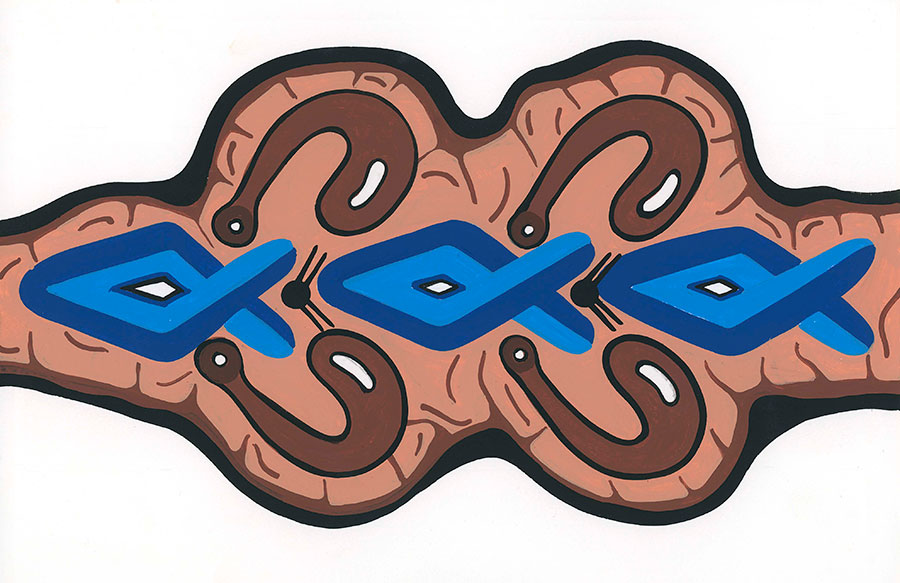
Leeanne Hunter - The Connected Brain
Acrylic on Paper 2017
In this artwork, Leeanne depicts a dissected brain, using a blue fish to demonstrate the pathway of pain management with the treatment of medication. The fish acts as the connecting receptors for the medications many people take to manage their pain.
The artwork depicts the hippocampus and the limbic system, which is involved with learning and memory.
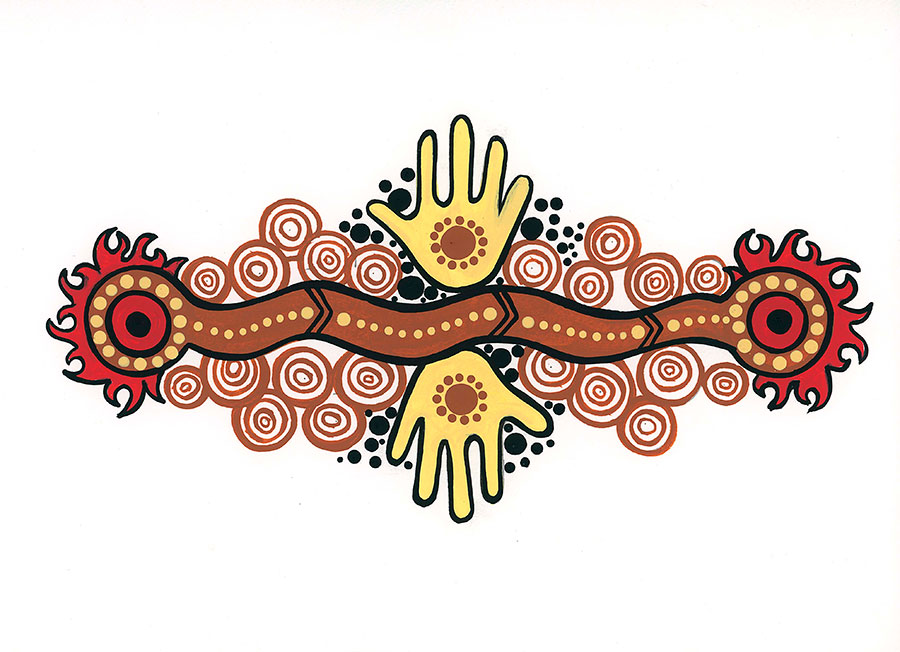
Leeanne Hunter - Overcoming Pain Thing
Acrylic on Paper 2017
Leeanne explains that the hands in this artwork are symbolic of healing and treatment provided by wrap around services. The circles of fire are used to symbolise the varying degrees of pain felt by a person.
The traditional symbol for travel, a line, is used to connect the two circles which represent the Country a person is on throughout their journey. The line is curved, however, to indicate the distress often associated with this journey.
The triple circles within the artwork highlight the vibrations of pain before a person receives treatment.

Suzy Evans
Acrylic Painting on board 2017
Suzy is a Gomeroi woman.
This painting 'Bengerang' is of a property 70 kilometres west of Moree; Suzy’s Country. It reflects a brighter future for life, one free from pain.
There is movement and colour, life free from violence. Pain is lessened when there is a safe, less stressful environment.
The pain will never go away, but removing factors that cause harm enables pain to be managed in a more positive holistic way.

Suzy Evans
Linocut design transferred onto silkscreens and printed, collage 2017
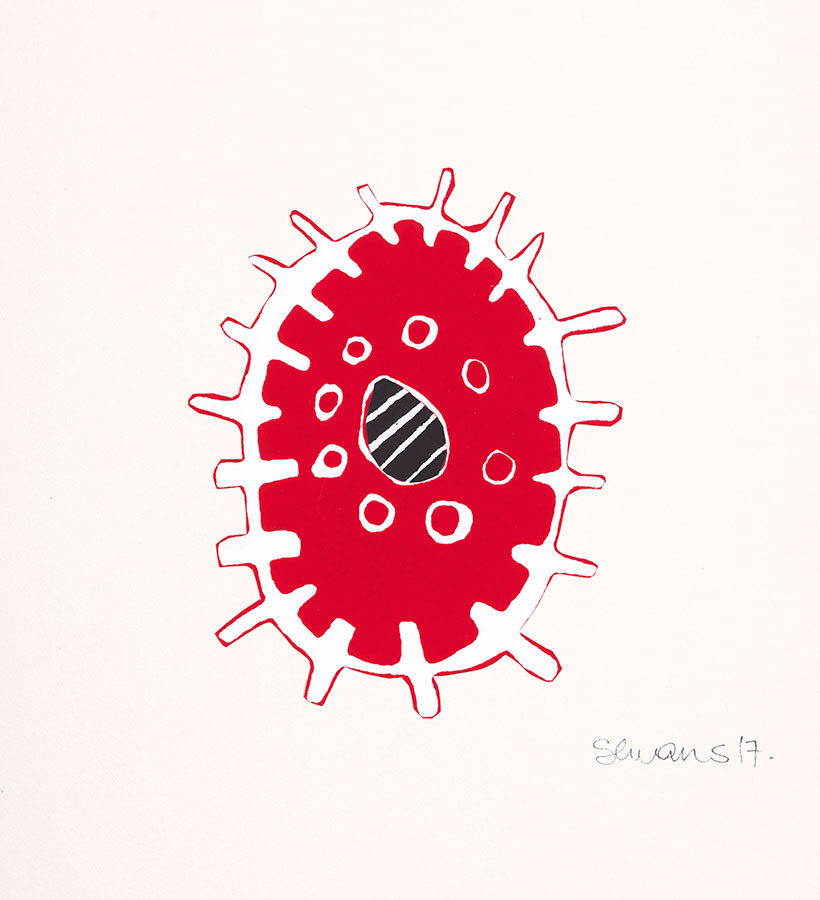
Suzy Evans
Linocut design transferred onto silkscreens and printed, collage 2017
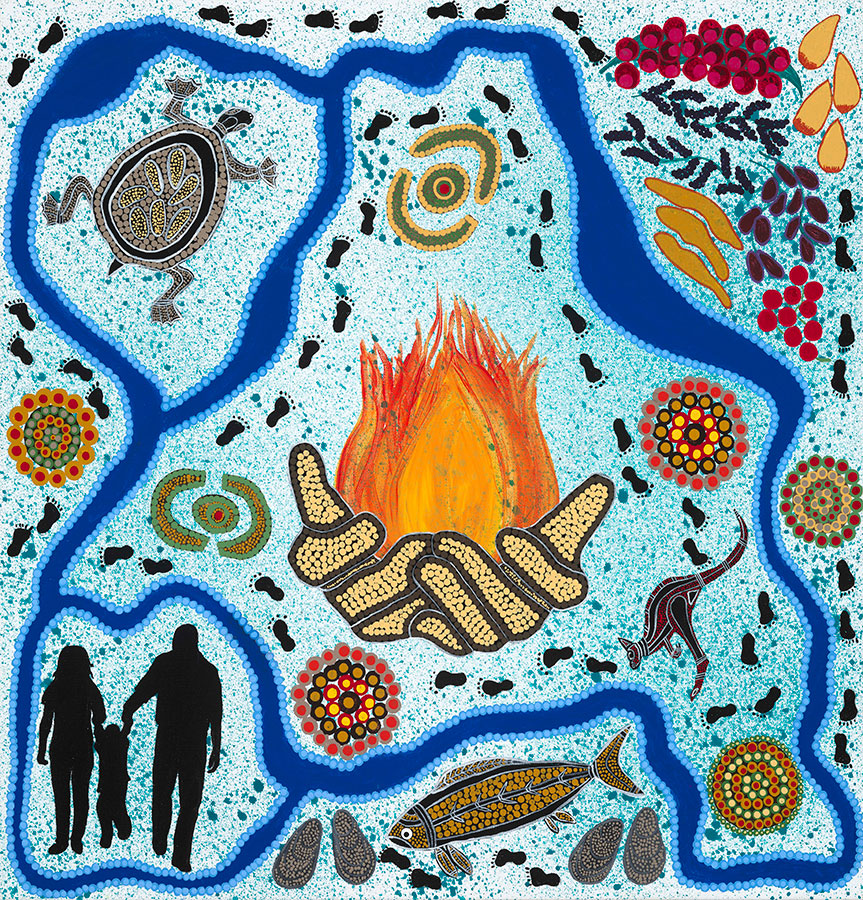
Tania Walker
Acrylic on Canvas 2017
Tania, a proud Bundjalung woman living in Casino, was inspired to do this artwork by the various health services available in her community for Aboriginal people.
The flame in the artwork illustrates the pain people experience, with the hand symbolic of the healing and care achieved when communities come together. The figures and footprints in the artwork are indicative of an active lifestyle alongside members of the community, with symbols representing healthy food included.
She has seen to many Aboriginal people dying from different chronic pains.
Her artwork is about healing the fire that is in the hand. The circles represent the communities coming together and helping one another. The footprints and figures are the people doing their exercise: walking with their families and friends.
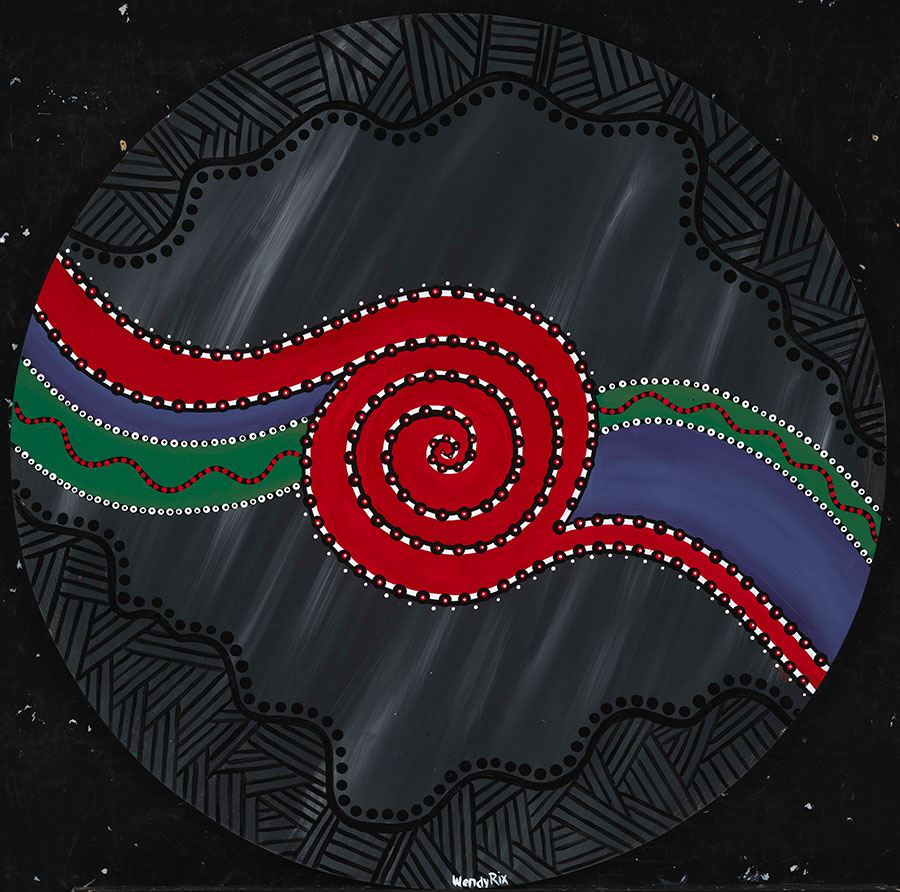
Wendy Rix
Acrylic on wood 2017
Wendy is a proud Yuwaalaraay woman from Goodooga NSW She says “There is nothing like that last bit of dirt road as you get near Country, and you feel home. When you sit on the river and listen to the wind, your questions are answered and you feel content”
As an artist and a Registered Nurse, Wendy has been through pain and pain management.
Wendy’s artwork depicts pain as a wave coming into the circle, with the red stripe indicating pain. The green stripes represent nausea and the general feeling of being unwell. The purple stripe represents hope: of wanting to feel better. The red circle is the constant roundabout of managing pain and medications, or non-medication techniques like distraction, heat, massage etc.
Videos
People of NSW
Illawarra
Cheree
Elvis
Joel
Troy
People of WA - Centre for Rural Health for the People of WA
I did it for the kids
Take care of your back & your baby
Get help and talk about it
On the road again
I don't want to be sidelined
Resources
- List of Aboriginal medical Services that are members to AHMRC
https://www.ahmrc.org.au/about/members - National Aboriginal Community Controlled organisations
https://www.naccho.org.au/acchos



